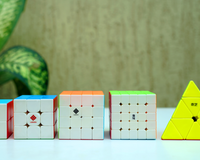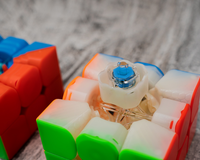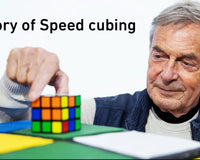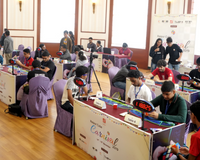Introduction
Have you ever wondered how the cubes in the 20th century were? Or the technological advances we will see in these cubes in a few years? Well, this blog will look at how these technological changes came about and try to foresee what these cubes will be like in the upcoming years.
Rubik’s Cube Technology has been rapidly improving over the past 50 years since it was invented and came into the market. We all know that Erno Rubik invented the Rubik's cube. He was a Hungarian inventor, architect, and Professor of Architecture.
Although it is widely reported that the Cube was originally built as a teaching tool to help his students understand 3D objects, his actual purpose was solving the structural problem of moving the parts independently without the entire mechanism falling apart. He did not realize that he had created a puzzle until the first time he scrambled his new Cube and then tried to restore it.

The First Cubes
The first cube created by Erno was quite different from the ones we have today. It was a plain wooden object which didn’t exactly look like a cube. After its patent, it was called the ‘Magic Cube’ and it was held together with interlocking plastic pieces that prevented the puzzle from being easily pulled apart.
A precursor of this cube, a 2x2x2 puzzle, was invented by Larry D. Nichols which was rather, held together by magnets.

The initially manufactured cubes were made of plastic and were stickered. The only adjustable system available in cubes at that time was the screw system. This system was used to change how loose or tight the cube was, as preferred by the cuber.
The cube pieces were not as mobile as in today's cubes. This restricted speed solving the cube for a few years. Speedcubes (still non-magnetic) started coming later on, enabling speedsolving and making groundbreaking records of those times.
Recommended Read - A History of Speedcubing

The 21st Century
Jumping into the 21st century, we have Gan producing its cubes. It was probably the most famous cube company for its innovative breakthrough designs, lightweight designs, etc.
One of the best breakthroughs in cubing technology was the introduction of magnets in pieces, allowing the cube to be more stable rather than flimsy like its predecessors. Magnets in cubes were invented in 2016, leading to various cubes to choose from. Almost all new cubes, ranging from budget to flagship cubes, had magnets.

Then comes the spring compression system, introduced by MoYu. An adjustable spring system helps to change the cubes’ stability. The higher the setting, the more stable the cube is, and vice versa.

Not only cubes with hardware updates have started to come, but we also have cubes with software updates, that is smart cubes. The cube can be connected to a phone via Bluetooth, enabling our solutions and times to record in its designated application. It also gives us insight into our solves and is really helpful for critiquing ourselves. It also provides a feature to race with other smart cube owners.
Read more - The Evolution of Cubing Hardware over the Years

Watch - Which smart cube is the smartest? | Lets Find out | Detailed Comparison | Sarthak Masta | Cubelelo

Recently, a self-solving Rubik's cube has also been invented.

We now have the latest technology in cubes, the MagLev technology. This type of technology used in Metro and bullet trains is introduced in cubes.
This system reduces the previously present friction between screws and the springs. With this technology, the springs can be replaced by the MagLev system, acting as a spring itself.
Future Cubing Technology?
Cubing technology has improved vastly in the past few decades. With the current technology available in society, cubing can be improved with adequate funding and participation. Continuous changes in the hardware structures of the cubes have given cubers a wide variety of options as well.

It has not only improved in basic events like the 2x2 and 3x3 but has also improved in side events like pyraminx, skewb, and megaminx. MagLev versions of such cubes have also been produced indicating the spread of new technology.
New technology can also help in making the inner layers better, like making lubes which are specifically provided for enhancing the inner layers of big cubes.
Robots can be set up in WCA competitions for scrambling the cubes to save time.
All such improvements will lead to cubing spreading out to different branches of today’s world like the chemical industry, physics, engineering, etc.
Cubing can also be turned into something like an entertaining device as well, like how some smart cubes in the present provide some fun games to play.
Fun prediction: Imagine in a few decades, having a cube that can be solved with just our brain!
Read On: The Evolution of Cubing Hardware over the Years
Conclusion
We’ll be wrapping up this blog with the above predictions I think can be implemented in the cubing world. Let me know your predictions in the comment sections below!
About Author

Sarthak Masta
Sarthak Masta is a speedcuber from Raipur. He started cubing in 2013 and now has 9 years of cubing experience. Apart from cubing, Sarthak enjoys making music and singing. He has attended a total of 7 competitions in Raipur and has gotten 10 podiums, with 2 gold medals, 4 silver medals and 4 bronze medals






























